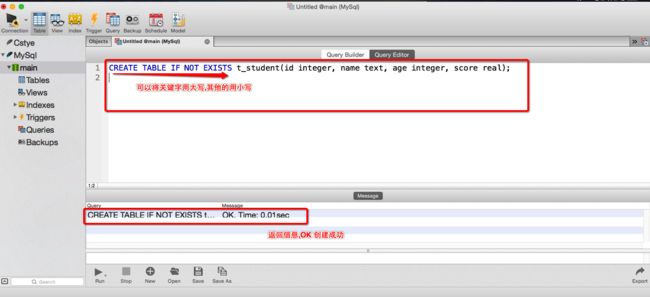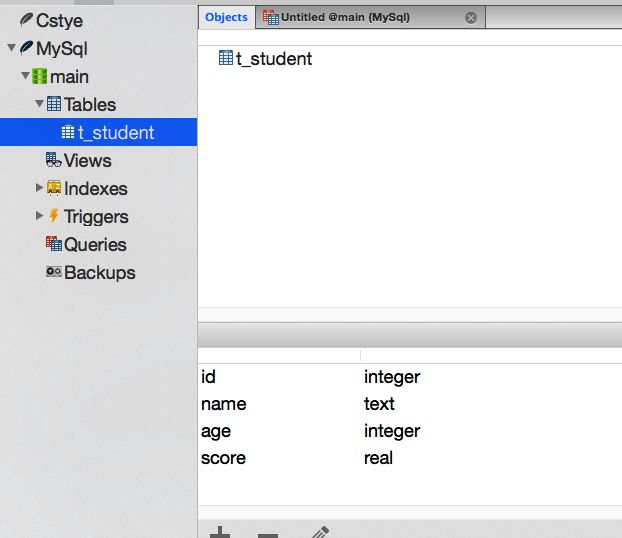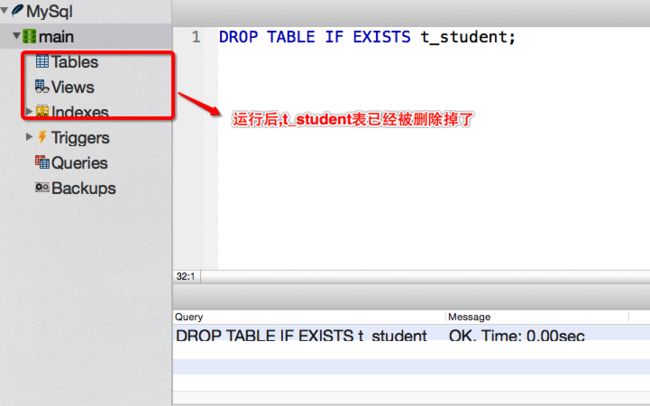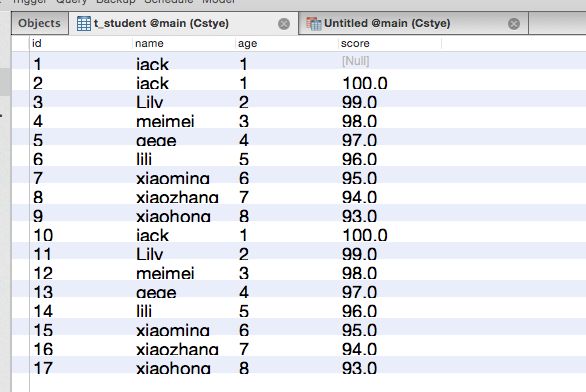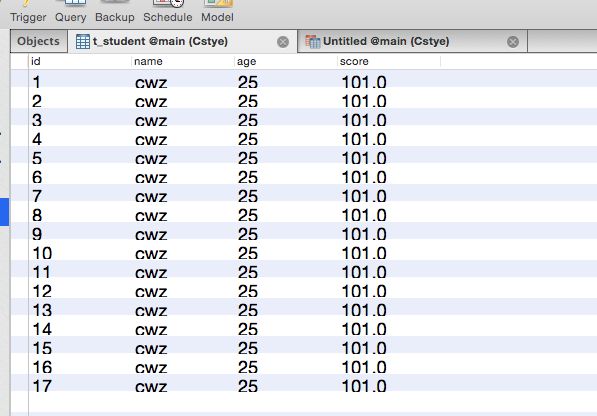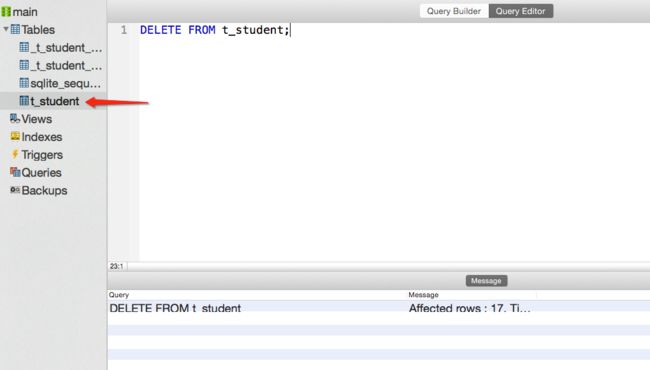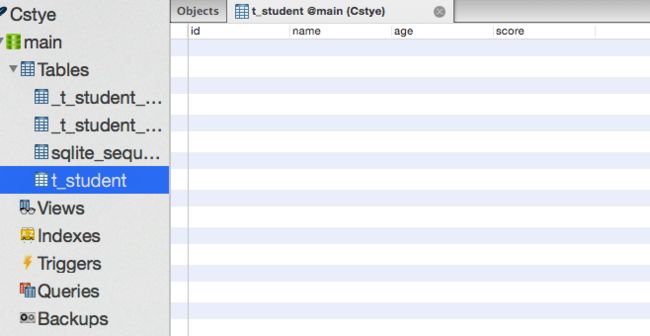1 - 什么是SQlite
- SQLite是一款轻型的嵌入式数据库
- SQLite数据库:可以存储大批量的数据
- 它占用资源非常的低,在嵌入式设备中,可能只需要几百K的内存就够了
- 它的处理速度比Mysql、PostgreSQL这两款著名的数据库都还快
- 数据库(Database)是按照数据结构来组织、存储和管理数据的仓库.
1.1 - 数据库可以分为2大种类:
- 关系型数据库(主流)
- 对象型数据库
- 常用关系型数据库
- PC端:Oracle、MySQL、SQL Server、Access、DB2、Sybase
- 嵌入式\移动客户端:SQLite
2 - 如何存储数据
- 数据库的存储结构和excel很像,以表(table)为单位来存储数据
2.1 - 数据库存储数据的步骤
- 新建一个数据库文件
- 新建一张表(table)
- 添加多个字段(column,列,属性)
- 添加多行记录(row,每行存放多个字段对应的值)
3 - SQL语句 (DDL DML DQL)
演示图片所用的软件为绿色版的Navicat.
3.1 - SQL语句的种类
- 3.1.1 - 数据定义语句(DDL:Data Definition Language)
- 包括
create(创表)和drop(删表)等操作 - 在数据库中创建新表或删除表(
create table或drop table) - 3.1.2 - 数据操作语句(DML:Data Manipulation Language)
- 包括
insert、update、delete等操作 - 上面的3种操作分别用于添加、修改、删除表中的数据
- 3.1.3 - 数据查询语句(DQL:Data Query Language)
- 可以用于查询获得表中的数据
- 关键字
select是DQL(也是所有SQL)用得最多的操作 - 其他DQL常用的关键字有
where,order by,group by和having
3.1.1 - DDL(数据定义语句)
创表格式
- create table 表名 (字段名1 字段类型1, 字段名2 字段类型2, …) ;
- create table if not exists 表名 (字段名1 字段类型1, 字段名2 字段类型2, …) ;
create table t_student (id integer, name text, age inetger, score real) ;
字段类型
SQLite将数据划分为以下几种存储类型:
integer : 整型值
real : 浮点值
text : 文本字符串
blob : 二进制数据(比如文件)
实际上SQLite是无类型的
就算声明为integer类型,还是能存储字符串文本(主键除外)
建表时声明啥类型或者不声明类型都可以,也就意味着创表语句可以这么写:
create table t_student(name, age);-
为了保持良好的编程规范、方便程序员之间的交流,编写建表语句的时候最好加上每个字段的具体类型
由于以上创表后是没有主键和自生长的 所以创建表最好的方式是:
-
在创表的时候附带主键和自生长

删表格式
- drop table 表名 ;
- drop table if exists 表名 ;
drop table t_student ;
3.1.2 - DML(数据操作语句)
- 插入数据(insert
- insert into 表名 (字段1, 字段2, …) values (字段1的值, 字段2的值, …) ;
示例
insert into t_student (name, age) values (jack’, 10) ;
- 注意
- 数据库中的字符串内容应该用单引号 ’ 括住;
- 更新数据(update)
update 表名 set 字段1 = 字段1的值, 字段2 = 字段2的值, … ;
update t_student set name = ‘jack’, age = 20 ;
- 注意
- 上面的示例会将t_student表中所有记录的name都改为jack,age都改为20
- 删除数据(delete)
delete from 表名 ;
delete from t_student ;
- 注意
- 上面的示例会将t_student表中所有记录都删掉
3.1.3 - DQL (条件语句)
- 如果只想更新或者删除某些固定的记录,那就必须在DML语句后加上一些条件
- 条件语句的常见格式
where 字段 = 某个值 ; // 不能用两个 =
where 字段 is 某个值 ; // is 相当于 =
where 字段 != 某个值 ;
where 字段 is not 某个值 ; // is not 相当于 !=
where 字段 > 某个值 ;
where 字段1 = 某个值 and 字段2 > 某个值 ; // and相当于C语言中的 &&
where 字段1 = 某个值 or 字段2 = 某个值 ; // or 相当于C语言中的 ||
// 将t_student表中年龄大于10 并且 姓名不等于jack的记录,年龄都改为 5
update t_student set age = 5 where age > 10 and name != ‘jack’ ;
// 删除t_student表中年龄小于等于10 或者 年龄大于30的记录
delete from t_student where age <= 10 or age > 30 ;
// 将t_student表中名字等于jack的记录,score字段的值 都改为 age字段的值
update t_student set score = age where name = ‘jack’ ;
- 查询数据
select 字段1, 字段2, … from 表名 ;
select * from 表名; // 查询所有的字段
select name, age from t_student ;
select * from t_student ;
select * from t_student where age > 10 ; // 条件查询
- 起别名(字段和表都可以起别名)
select 字段1 别名 , 字段2 别名 , … from 表名 别名 ;
select 字段1 别名, 字段2 as 别名, … from 表名 as 别名 ;
select 别名.字段1, 别名.字段2, … from 表名 别名 ;
// 给name起个叫做myname的别名,给age起个叫做myage的别名
select name myname, age myage from t_student ;
// 给t_student表起个别名叫做s,利用s来引用表中的字段
select s.name, s.age from t_student s ;
- 计算记录的数量
select count (字段) from 表名 ;
select count ( * ) from 表名 ;
select count (age) from t_student ;
select count ( * ) from t_student where score >= 60
- 排序
- 查询出来的结果可以用order by进行排序
select * from t_student order by 字段 ;
select * from t_student order by age ;
- 默认是按照升序排序(由小到大),也可以变为降序(由大到小)
select * from t_student order by age desc ; //降序
select * from t_student order by age asc ; // 升序(默认)
- 也可以用多个字段进行排序
// 先按照年龄排序(升序),年龄相等就按照身高排序(降序)
select * from t_student order by age asc, height desc ;
- 分页 - limit常用来做分页查询,比如每页固定显示5条数据,那么应该这样取数据
第1页:limit 0, 5
第2页:limit 5, 5
第3页:limit 10, 5
第n页:limit 5*(n-1), 5
- 猜猜下面语句的作用
select * from t_student limit 7 ;
相当于select * from t_student limit 0, 7 ;
表示取最前面的7条记录
主键和约束
- 简单约束
- 建表时可以给特定的字段设置一些约束条件,常见的约束有
- not null :规定字段的值不能为null
- unique :规定字段的值必须唯一
- default :指定字段的默认值
(建议:尽量给字段设定严格的约束,以保证数据的规范性)
create table t_student (id integer, name text not null unique, age integer not null default 1) ;
name字段不能为null,并且唯一
age字段不能为null,并且默认为1
主键约束
- 如果t_student表中就name和age两个字段,而且有些记录的name和age字段的值都一样时,那么就没法区分这些数据,造成数据库的记录不唯一,这样就不方便管理数据
- 良好的数据库编程规范应该要保证每条记录的唯一性,为此,增加了主键约束
- 也就是说,每张表都必须有一个主键,用来标识记录的唯一性
什么是主键
- 主键(Primary Key,简称PK)用来唯一地标识某一条记录
- 例如
t_student可以增加一个id字段作为主键,相当于人的身份证 - 主键可以是一个字段或多个字段
主键的设计原则
- 主键应当是对用户没有意义的
- 永远也不要更新主键
- 主键不应包含动态变化的数据
- 主键应当由计算机自动生成
主键的声明
- 在创表的时候用primary key声明一个主键
create table t_student (id integer primary key, name text, age integer) ;
pinteger类型的id作为t_student表的主键
主键字段
只要声明为primary key,就说明是一个主键字段
主键字段默认就包含了not null 和 unique 两个约束
如果想要让主键自动增长(必须是integer类型),应该增加
autoincrement
create table t_student (id integer primary key autoincrement, name text, age integer) ;
外键约束
- 利用外键约束可以用来建立表与表之间的联系
- 外键的一般情况是:一张表的某个字段,引用着另一张表的主键字段
新建一个外键
create table t_student (id integer primary key autoincrement, name text, age integer, class_id integer, constraint fk_t_student_class_id_t_class_id foreign key (class_id) (id)) ; references t_class
- t_student表中有一个叫做fk_t_student_class_id_t_class_id的外键
- 这个外键的作用是用t_student表中的class_id字段引用t_class表的id字段
表链接
什么是表连接查询
- 需要联合多张表才能查到想要的数据
表连接的类型
内连接:inner join 或者 join (显示的是左右表都有完整字段值的记录)
左外连接:left outer join (保证左表数据的完整性)
查询1020班的所有学生
select s.name,s.age from t_student s, t_class c where s.class_id = c.id and c.name = ‘1020’;
FMDB
- FMDB是iOS平台的SQLite数据库框架
- FMDB以OC的方式封装了SQLite的C语言API
- 使用起来更加面向对象,省去了很多麻烦、冗余的C语言代码
- 对比苹果自带的Core Data框架,更加轻量级和灵活
- 提供了多线程安全的数据库操作方法,有效地防止数据混乱
FMDB有三个主要的核心类
1 - FMDatabase
- 一个FMDatabase对象就代表一个单独的SQLite数据库
- 用来执行SQL语句
2 - FMResultSet
- 使用FMDatabase执行查询后的结果集
3 - FMDatabaseQueue
- 用于在多线程中执行多个查询或更新,它是线程安全的
打开数据库
- 通过指定SQLite数据库文件路径来创建FMDatabase对象
FMDatabase *db = [FMDatabase databaseWithPath:path];
if (![db open]) {
NSLog(@"数据库打开失败!");
}
文件路径有三种情况
- 1 - 具体文件路径
- 如果不存在会自动创建
- 2 - 空字符串@""
- 会在临时目录创建一个空的数据库
- 当FMDatabase连接关闭时,数据库文件也被删除
- 3 - nil
- 会创建一个内存中临时数据库,当FMDatabase连接关闭时,数据库会被销毁
执行更新
- 在FMDB中,除查询以外的所有操作,都称为“更新”
- create、drop、insert、update、delete等
使用executeUpdate:方法执行更新
- (BOOL)executeUpdate:(NSString*)sql, ...
- (BOOL)executeUpdateWithFormat:(NSString*)format, ...
- (BOOL)executeUpdate:(NSString*)sql withArgumentsInArray:(NSArray *)arguments
[db executeUpdate:@"UPDATE t_student SET age = ? WHERE name = ?;", @20, @"Jack"];
执行查询
- 查询方法
- (FMResultSet *)executeQuery:(NSString*)sql, ...
- (FMResultSet *)executeQueryWithFormat:(NSString*)format, ...
- (FMResultSet *)executeQuery:(NSString *)sql withArgumentsInArray:(NSArray *)arguments
// 查询数据
FMResultSet *rs = [db executeQuery:@"SELECT * FROM t_student"];
// 遍历结果集
while ([rs next]) {
NSString *name = [rs stringForColumn:@"name"];
int age = [rs intForColumn:@"age"];
double score = [rs doubleForColumn:@"score"];
}
FMDatabaseQueue
- FMDatabase这个类是线程不安全的,如果在多个线程中同时使用一个FMDatabase实例,会造成数据混乱等问题
- 为了保证线程安全,FMDB提供方便快捷的FMDatabaseQueue类
FMDatabaseQueue的创建
FMDatabaseQueue *queue = [FMDatabaseQueue databaseQueueWithPath:path];
简单使用
[queue inDatabase:^(FMDatabase *db) {
[db executeUpdate:@"INSERT INTO t_student(name) VALUES (?)", @"Jack"];
[db executeUpdate:@"INSERT INTO t_student(name) VALUES (?)", @"Rose"];
[db executeUpdate:@"INSERT INTO t_student(name) VALUES (?)", @"Jim"];
FMResultSet *rs = [db executeQuery:@"select * from t_student"];
while ([rs next]) {
// …
}
}];
使用事务
[queue inTransaction:^(FMDatabase *db, BOOL *rollback) {
[db executeUpdate:@"INSERT INTO t_student(name) VALUES (?)", @"Jack"];
[db executeUpdate:@"INSERT INTO t_student(name) VALUES (?)", @"Rose"];
[db executeUpdate:@"INSERT INTO t_student(name) VALUES (?)", @"Jim"];
FMResultSet *rs = [db executeQuery:@"select * from t_student"];
while ([rs next]) {
// …
}
}];
事务回滚
*rollback = YES;
